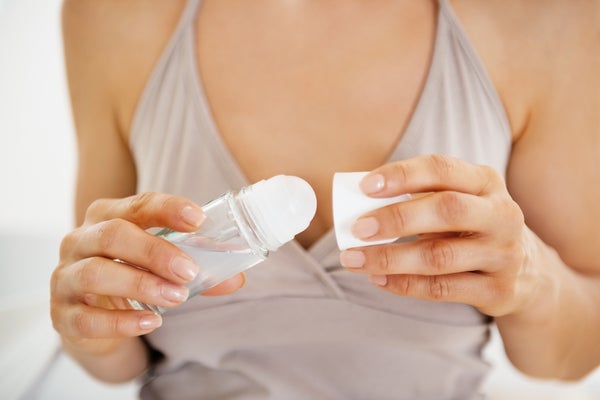Full-body deodorants are undoubtedly having a moment. Commercials and ads have flooded airways and social media with a lineup of fragrant creams, sticks, sprays and roll-ons to apply on virtually any area of skin, from places such as the genitalia and “underboobs” to the feet, belly or anywhere someone might want odor prevention.
It’s not clear if these products are suddenly proliferating because of spontaneous public demand—but targeted marketing that’s convincing people they smell is a driving factor. Lume whole-body deodorant, which came out in 2017, is often said to have kickstarted the trend. Since then nearly every major manufacturer line has followed suit, including Secret, Dove, Native, Ban—the list goes on. The earlier products were geared toward women, but in more recent years brands such as Mando and Old Spice and products from Dove’s Men+Care line have further expanded the market share. One survey conducted by Dove found that 76 percent of respondents said that they would be willing to try one of these products. But some experts question how effective such items really are at eliminating odor, whether they’re safe to apply all over the body—particularly in sensitive, private areas—and if they are necessary in the first place.
Whole-body odor reduction products come in two main categories: deodorants and antiperspirants. Both contain many of the same ingredients as underarm-specific varieties but are intended to be applied over large swaths of the body—the genitalia, feet, thighs and chest—says Jonathan Schimmel, a medical toxicologist and assistant professor of emergency medicine at the Icahn School of Medicine at Mount Sinai in New York City. Unpleasant body odor typically comes from natural bacteria that feed on sweat on the skin’s surface. Deodorants work by using an antimicrobial compound, such as triclosan, to kill some of the odor-causing bacteria. Any remaining odor is masked with fragrance molecules. Whole-body antiperspirants, on the other hand, contain aluminum compounds designed to block sweat glands. This keeps perspiration from reaching the skin’s surface to combine with bacteria and cause odor.
On supporting science journalism
If you're enjoying this article, consider supporting our award-winning journalism by subscribing. By purchasing a subscription you are helping to ensure the future of impactful stories about the discoveries and ideas shaping our world today.
Deodorants and antiperspirants have different mechanisms—and they are also regulated differently by the U.S. Food and Drug Administration. “Deodorants are considered cosmetic products, and companies have some latitude to choose which compounds to add, while antiperspirants are classified as a drug and regulated by the FDA,” Schimmel says.
The main safety concern that occasionally gets raised over antiperspirants is the use of aluminum, which can be toxic at very high concentrations. But antiperspirants, including whole-body ones, can only contain one of 18 regulated aluminum compounds listed as safe by the FDA in certain percentages. Many studies on antiperspirants have found low risk of aluminum absorption and no significant adverse effects. A comprehensive research review, published in 2014 in Critical Reviews in Toxicology, found no clear evidence that using aluminum-containing underarm antiperspirants or cosmetics increased the risk of Alzheimer’s disease or breast cancer.
In people with sensitive skin, antiperspirants can cause irritant dermatitis: inflammation and itchiness at the area where the sweat glands are blocked. “If you were to apply it all over, you could imagine getting the same irritant dermatitis all over your body,” says Theodora K. Karagounis, a board-certified dermatologist and clinical assistant professor at NYU Grossman School of Medicine.
Whole-body deodorants use ingredients that are generally considered safe, but people with sensitive skin should be cautious when it comes to fragrances; aromatic compounds in scents could trigger an allergic reaction called contact dermatitis, which causes an itchy rash. In fact, deodorants are the leading cause of allergic dermatitis, according to a 2011 study published in Contact Dermatitis. “If you have sensitive skin, you’ll want to choose products that are designed for sensitive skin and are fragrance-free,” says Natalie Hone, a board-certified dermatologist with The Skin People, a medical and cosmetic dermatology practice in the Houston area. It’s also a good idea to test these whole-body products on a patch of skin for two weeks daily before applying them all over the body. And neither an antiperspirant nor a deodorant should be used internally, in, for example, the vagina, which is self-cleaning.
Scientific American reached out to three whole-body deodorant and antiperspirant manufacturers for comment. Only Unilever, the maker of Dove’s whole-body products, responded by the time of publication. Diane Keenan, associate research and development director at Unilever, says all of the company’s products have been approved by independent dermatologists, and the cream version of the whole-body deodorant line has specifically been gynecologist-tested on humans. “Those with specific allergy concerns should read the product ingredient list and consult their doctor prior to using,” Keenan says. “As with any product, if you experience irritation while using this product, stop using it and consult your doctor.”
Whole-body deodorants and antiperspirants can be effective at fighting excessive sweating in some people, Hone says, particularly those with hyperhidrosis—a nervous system condition that causes overactive sweat glands and affects about 5 percent of the U.S. population. Hyperhidrosis can also be caused by secondary health issues such as diabetes, menopause, thyroid dysfunction and anxiety. The condition is still commonly treated with medications including glycopyrrolate or Botox (botulinum toxin) injections, but Hone suggests that whole-body deodorants and antiperspirants might be a good over-the-counter alternative.
Most people are also able to keep sweat and odor in check with regular showering and underarm deodorant. Still, people in many Western countries have long been particularly (and sometimes obsessively) nervous about bodily odors—leaving plenty of lucrative opportunities for industry. “These products are trendy and just another tool in our arsenal against sweat and odor,” Hone says. “It used to be that people used perfume to mask odor, and now we have this.”
